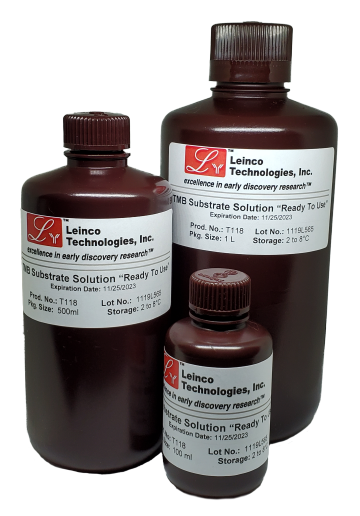Selecting The Correct Enzyme Substrate For Your ELISA
When developing an assay, it is important to consider your substrate selection carefully and to have an understanding of your assay’s requirements. ELISA substrates vary in dynamic range, kinetic rate, sensitivity, stability, background, and additional parameters. Leinco Technologies offers a range of buffers and substrates for optimizing ELISA’s while exhibiting superior performance and lot to lot consistency.
Features to Consider
- Dynamic Range: Important consideration when an assay requires quantitation of a large range of analyte concentrations.
- Kinetic Rate: Depending on your assay’s requirements, kinetic rate can impact sensitivity levels. Substrates with a ‘faster’ kinetic rate often given higher signal on concentration levels while increasing sensitivity, but can cause limited dynamic ranges.
- Sensitivity vs. Detection: Both sensitivity and detection limits have an effect on immunoassay design and results. Sensitivity determines the assays signal magnitude, while detection determines the error in signal measurement. These are both important factors to consider when developing your assay.
- Stability: Overtime, when substrates are stored for long period of times and at specific temperatures, the substrates color and performance should remain consistent. Leinco has conducted stability tests and concluded the quality of the substrate can be preserved when stored at a minimum of 48 months and at 2-8ºC.
- Background: High signal-to-noise ratio reduces overall background noise in your assay, allowing for proper interpretation of results. High background noise can interfere with your data results.

Substrates for HRP
TMB Substrates
TMB (tetramethylbenzidine), a chromogenic substrate, is common in numerous staining procedures when detecting HRP (Horseradish Peroxidase). TMB is one of the most versatile forms of substrates. The use of high-quality assay reagents is critical during any stage of assay development or assay results.
Traditional Substrates
UltraSensitive™
Additional TMB Substrates
TMB Stop Reagents
Substrates for ALP
pNPP Substrates
pNPP (para-Nitrophenylphosphate), a non-proteinaceous chromogenic substrate, is common used for detecting ALP (Alkaline Phosphatase) staining in ELISA assays. pNPP produces a yellow water-soluble reaction that absorbs light at 405 nm.

